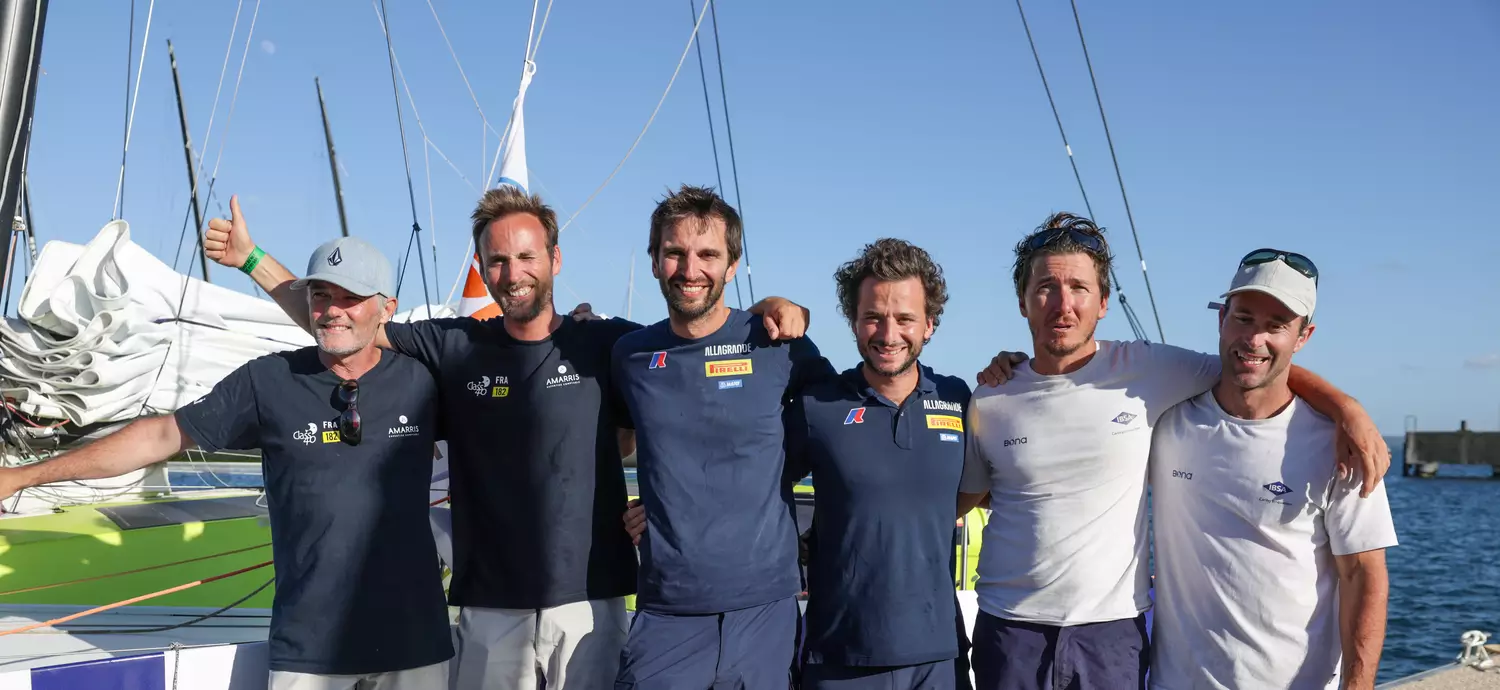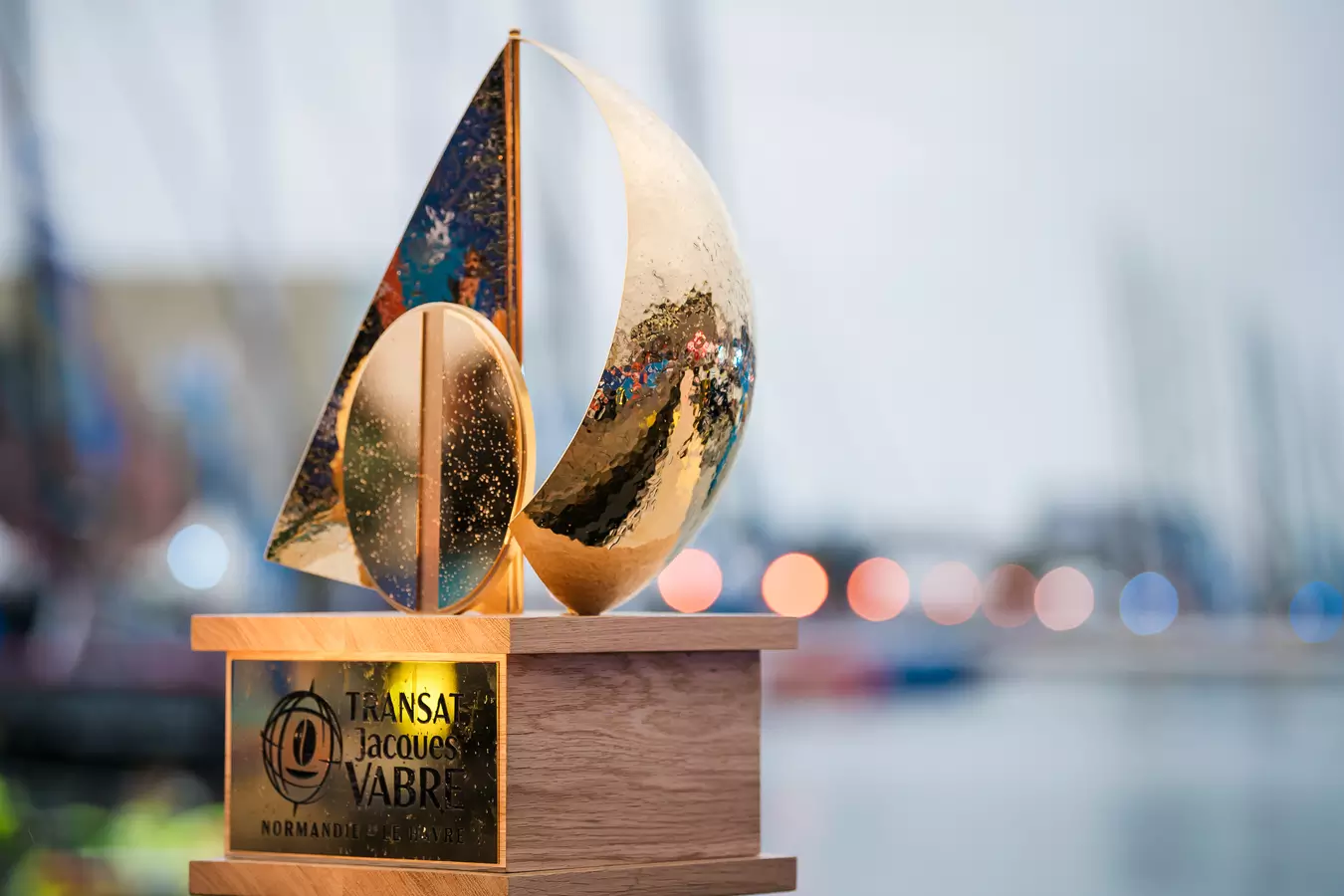Transat Jacques Vabre 12.11.2017
12.11.2017
Coville and Josse heading for record-breaking photo finish in Salvador de Bahia tomorrow
After 4,350 miles descending the Atlantic from Le Havre to Salvador de Bahia, the 13th edition of the Transat Jacques Vabre could come down to a photo finish between the older warhorse, Sodebo Ultim’, and the young stallion, Maxi Edmond de Rothschild.
The two huge trimarans, both over 30 metres long, are expected to cross the finish line in the Bay of All Saints between 12 and 16:00 UTC tomorrow. Seb Josse, the skipper of Maxi Edmond de Rothschild, was spot on when he predicted an eight-day finish three days before the start.
At 16:00 UTC today Sodebo Ultim’ had a 40-mile lead, but in patchy easterlies off the north-east coast of Brazil was four knots slower than its more powerful pursuer. By the evening with boats getting back towards 30 knots there may be little more than an hour between them.
Whoever wins, the race record will be smashed. The fastest finish to Salvador remains Franck Cammas on Groupama 2’s astonishing 10day 0h 38min win in 2007 in the 60ft multihull class.
For Thomas Coville, the skipper of Sodebo Ultim’ it would a second Transat Jacques Vabre victory to add to his 1999 win on a very different beast – an Imoca 60ft monohull. Coville has concentrated more on solo round-the-world records in trimarans since and broke the record in December. For he and co-skipper Jean-Luc Nélias it is a measure of revenge after another newly-launched maxi, François Gabart’s Macif beat them in 2015.
Maxi Edmond de Rothschild skipper Seb Josse’s best finishing time was his 11days 5 hours 3min win with Charles Caudrelier on the MOD70 trimaran Edmond de Rothschild in the 2013 edition – that time to Itajaí, Brazil.
The dilemma for Coville and Nélias is that they do not know if Josse and Thomas Rouxel’ boat have a technical problem and whether they can control the race against a potentially more powerful rival.
“Even with their technical problem they’re going at the same speed as us,” Nélias said. “Control is the whole problem, it’s possible if you’re going at the same speed, with the same boat in the same class, but now we don’t know if can control them or whether they’re going to go faster,”
Nélias predicts a complicated light upwind finish after the north-easterly drag race down the coast.
Multi50
The first Multi50s (just after the last Ultime, Prince de Bretagne) entered the Doldrums – still loitering at 7°N this afternoon, going through what they hope will be the fastest door between the 28°W and the 30°W. According to Richard Silvani of Météo France: “As for the Ultime, there is a mouse hole there where the activity is less, the Multi50 should not be too slow.” Erwan Leroux et Vincent Riou on FenêtréA – Mix Buffet have not escaped from Lalou Roucayrol and Alex Pella on Arkema, who stemmed the losses and then made 10 miles back today to be 93 miles behind with 1,300 miles of the racetrack left.
Imoca
The Imoca are passing the Cape Verde archipelago. As predicted by SMA yesterday, west is best, so the fleet has refined its trajectory, gybing behind St Michel-Virbac. That manoeuvring has cost every one miles to the leader, with SMA and Des Voiles et Vous! now 60 and 117 miles behind respectively. British skipper, Sam Davies, with Tanguy de Lamotte on Initiatives-Cœur – despite a mast climb – have moved from seventh into fifth, but have lost about 80 miles on the leader in the last 24 hours and are now 226 miles behind. All are positioning themselves for what they hope will be the best route through the ITCZ (Intertropical Convergence Zone, aka the Doldrums), but it is still too early to know how active it will be. The leaders will start entering the Doldrums overnight into Tuesday.
Class40
Phil Sharp and Pablo Santurde (Imerys Clean Energy) are watching their lead get nibbled away to six miles as the frontrunners flirt with a ridge of high pressure between the Canaries and Cape Verde generated by a depression in the west that is moving north. Imerys’s speed has dropped to under 8 knots, while those positioned further east are finding more pressure. The depression is momentarily breaking the trade wind. Sharp, still battling with communications and weather files on his back-up Satcom after an antenna failure, explained that the loss of 30 miles of their lead had come from finding a mountain of seaweed on their keel. He was forced to stop and dive under the boat to check.
Pit stops
Esprit Scout (Class40)
At midday Jacques-Arnaud Seyrig and Marc Dubos warned the Transat Jacques Vabre race office of serious delamination of their hull on the port bow, from the waterline to the deck and 30 cm wide. Water is seeping into the forward watertight bulkhead causing a leak into the boat. The two skippers made the decision to sail upwind on port tack to the Canary Islands in order to stay on the sound side of the boat. They are 130 miles away from Tenerife, which they should reach by the end of the night.
Ciela Village (Class40)
Thierry Bouchard and Oliver Krauss arrived in Mindelo on the island of São Vicente on Cape Verde at 13:45 UTC. A technical team was mobilised to solve the autopilot problems, which have forced the two skippers to helm constantly since the second day of race.
Les mots des partenaires
Phil Sharp, skipper, Imerys Clean Energy (Class40)
“The top three of the Class 40s are all in a state of compression as we on Imerys Clean Energy hit light airs, just to the west of V&B and Aina. It’s tricky conditions for us right now. We have the spinnaker up and are trying to make way towards the Cape Verdes, as the others further east gobble up our margin… Hope things will turn in our favour soon… It’s funny how we’ve been dreaming of light airs all week and now we are reminded that less wind is also challenging! We are pretty much half way to Brazil, which is unbelievable. I guess we have sailed quite a way in the first week… We’ve averaged around 300 miles per day, which is not bad going for us small, but nimble 40 footers. It’s evident how quickly we have sailed south just by what an incredible contrast the weather is down here in the tropics compared to just three days ago further north. Then, I was waking up cold from a sleeping bag in full thermals. Today, I finally took the last of my thermals off before perspiring to oblivion, and we are now in shorts and t-shirts, whilst having to overload on sun cream. I guess we deserved a bit of a break after several insanely wet days in 30 knots wind. Funnily enough, just as we move into the tropics, our Jetboil has now randomly started working again (maybe it has just thawed-out?!) which means no more cold freeze dried and – get this – we can actually have a cup of tea after literally DAYS without any. Although I think ice tea is more appealing right now! Next up: Getting round (or through??) the Cape Verdes… This will definitely not be plain sailing.”
Jean-Luc Nélias, co-skipper, Sodebo Ultim’ (Ultime)
“Thomas has gone jogging, he’s not here (laughing). It’s going well, the sun is warming our bones and Thomas is in the bunk and we are slowly approaching Brazil. I won’t say too much, but it’s looking very technical, we will keep our plans to ourselves now, at this time of digital communication. We’ll arrive downwind in strong breeze all the way up until Salvador de Bahia and then there will be a little wind hole in the morning, and probably an upwind finish, so all the ingredients for a difficult arrival are there. We’re well rested, there will inevitably be pressure, but to win a race you have to beat someone. We’ve been in the lead for a few days after Ushant. They went faster than us in the Channel, but we take as it comes. It’s like bike races, you don’t know when the attack will come, you wait, it doesn’t come and then all of a sudden the attack happens. We know the boat, the percentages of the boat, it is a beautiful for going around the world and setting the record (Thomas Coville broke the solo circumnavigation record in December) but for a battle (like this) it’s not easy. There are holes. We have the impression that they (Edmond de Rothschild) rolled away their gennaker off the Canaries; they luffed for a few hours and since then they haven’t shown the speed we expected, but even with their technical problem they’re going at the same speed as us. Control is the whole problem, it’s possible if you’re going at the same speed, with the same boat in the same class, there you do have control, but now we don’t know if can control them or whether they’re going to go faster, do we give the best trajectory we believe, if it believes that the same trajectory, it follows you, every hour we are marked, we control, they control, this leaves little opportunity Tomorrow in the day … In the morning, that’s what the routing tells us.”











